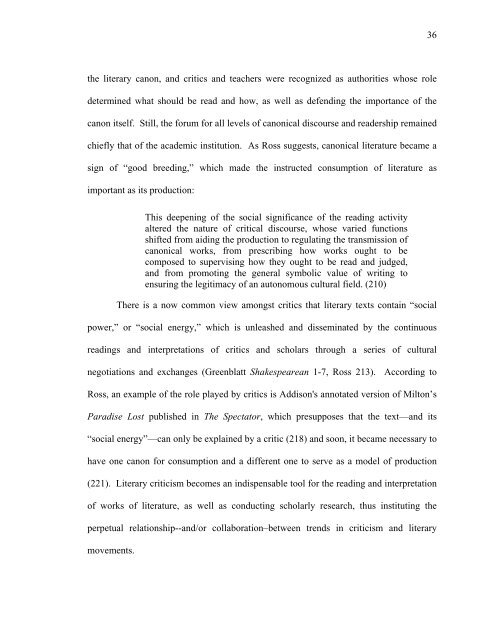Untitled - Sexey's School Moodle
Untitled - Sexey's School Moodle
Untitled - Sexey's School Moodle
You also want an ePaper? Increase the reach of your titles
YUMPU automatically turns print PDFs into web optimized ePapers that Google loves.
the literary canon, and critics and teachers were recognized as authorities whose role<br />
determined what should be read and how, as well as defending the importance of the<br />
canon itself. Still, the forum for all levels of canonical discourse and readership remained<br />
chiefly that of the academic institution. As Ross suggests, canonical literature became a<br />
sign of “good breeding,” which made the instructed consumption of literature as<br />
important as its production:<br />
This deepening of the social significance of the reading activity<br />
altered the nature of critical discourse, whose varied functions<br />
shifted from aiding the production to regulating the transmission of<br />
canonical works, from prescribing how works ought to be<br />
composed to supervising how they ought to be read and judged,<br />
and from promoting the general symbolic value of writing to<br />
ensuring the legitimacy of an autonomous cultural field. (210)<br />
There is a now common view amongst critics that literary texts contain “social<br />
power,” or “social energy,” which is unleashed and disseminated by the continuous<br />
readings and interpretations of critics and scholars through a series of cultural<br />
negotiations and exchanges (Greenblatt Shakespearean 1-7, Ross 213). According to<br />
Ross, an example of the role played by critics is Addison's annotated version of Milton’s<br />
Paradise Lost published in The Spectator, which presupposes that the text—and its<br />
“social energy”—can only be explained by a critic (218) and soon, it became necessary to<br />
have one canon for consumption and a different one to serve as a model of production<br />
(221). Literary criticism becomes an indispensable tool for the reading and interpretation<br />
of works of literature, as well as conducting scholarly research, thus instituting the<br />
perpetual relationship--and/or collaboration–between trends in criticism and literary<br />
movements.<br />
36



